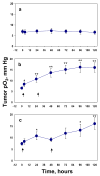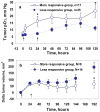Repeated tumor pO(2) measurements by multi-site EPR oximetry as a prognostic marker for enhanced therapeutic efficacy of fractionated radiotherapy
- PMID: 19013657
- PMCID: PMC2692261
- DOI: 10.1016/j.radonc.2008.10.015
Repeated tumor pO(2) measurements by multi-site EPR oximetry as a prognostic marker for enhanced therapeutic efficacy of fractionated radiotherapy
Abstract
Purpose: To investigate the temporal effects of single or fractionated radiotherapy on subcutaneous RIF-1 tumor pO(2) and to determine the therapeutic outcomes when the timing of fractionations is guided by tumor pO(2).
Methods: The time-course of the tumor pO(2) changes was followed by multi-site electron paramagnetic resonance (EPR) oximetry. The tumors were treated with single 10, 20, and 10 Gy x 2 doses, and the tumor pO(2) was measured repeatedly for six consecutive days. In the 10 Gy x 2 group, the second dose of 10 Gy was delivered at a time when the tumors were either relatively oxygenated or hypoxic. The changes in tumor volumes were followed for nine days to determine the therapeutic outcomes.
Results: A significant increase in tumor pO(2) was observed at 24h post 10 Gy, while 20 Gy resulted in a significant increase in tumor pO(2) at 72-120 h post irradiation. The tumors irradiated with a second dose of 10 Gy at 24h, when the tumors were oxygenated, had a significant increase in tumor doubling times (DTs), as compared to tumors treated at 48 h when they were hypoxic (p<0.01).
Conclusion: Results indicate that the time of tumor oxygenation depends on the irradiation doses, and radiotherapeutic efficacy could be optimized if irradiations are scheduled at times of increased tumor oxygenation. In vivo multi-site EPR oximetry could be potentially used to monitor tumor pO(2) repeatedly during fractionated schemes to optimize radiotherapeutic outcome. This technique could also be used to identify responsive and non-responsive tumors, which will facilitate the design of other therapeutic approaches for non-responsive tumors at early time points during the course of therapy.
Figures




References
-
- Hall EJ. Radiobiology for the radiologist. 6. Philadelphia: Lippincott Williams & Wilkins; 2006. pp. 85–105.
-
- O’Hara JA, Goda F, Demidenko E, Swartz HM. Effect on regrowth delay in a murine tumor of scheduling split-dose irradiation based on direct pO2 measurements by electron paramagnetic resonance oximetry. Radiat Res. 1998;150:549–556. - PubMed
-
- Znati CA, Rosenstein M, Boucher Y, Epperly MW, Bloomer WD, Jain RK. Effect of radiation on interstitial fluid pressure and oxygenation in a human tumor xenograft. Cancer Res. 1996;56:964–968. - PubMed
-
- Vaupel P, Frinak S, O’Hara M. Direct measurement of reoxygenation in malignant mammary tumors after a single large dose of irradiation. Adv Exp Med Biol. 1984;180:773–782. - PubMed
Publication types
MeSH terms
Substances
Grants and funding
LinkOut - more resources
Full Text Sources
Miscellaneous

